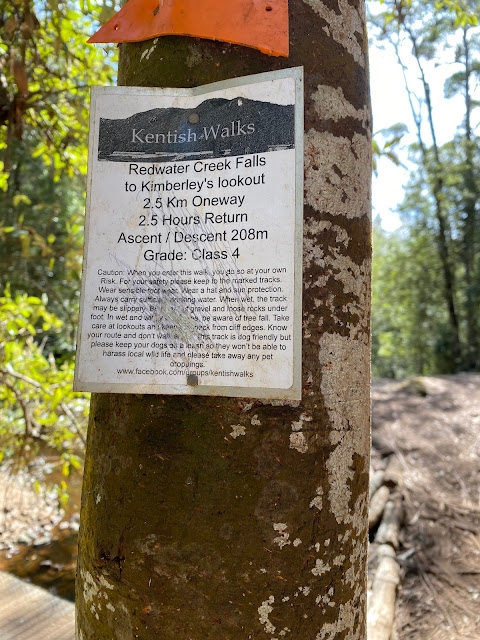 |
Campground at the Railton Pub
|
Expecting to tackle Redwater Creek Falls the next day, I stayed at the campground at the Railton Hotel that night. I was the only person there. Perhaps the place rocks on Saturday nights or right
through the summer. The manager/publican had already informed me somewhat
tersely that there would be no counter meals tonight and the pub would be
closing at 6 pm.
No problem I said. I still had some Wagu sausages and my main
reason for staying was to have a shower.
I’ve never seen so many signs. A few samples follow. One can only wonder what horrors the writer must
have experienced to make them necessary, but everything was clean and tidy and
the hot shower was extremely welcome.
 |
| Sign of the times - this was one of 10 |
|

I always bring lots of things to do on trips like this. Since I even had a signal tonight I could have done some writing or I could have read one of the books I'd brought, but somehow I never feel like it.
I had just settled
down for the night to the familiar sound of Pobblebonk frogs in the creek at
the foot of the campground, when an orange glow began to light up the sky and a
low rumble began. It came closer and
closer. Suddenly two super bright lights appeared and a very long train clacked and clacked its way all along the fence on the left side of the campground. When it reached the main street it gave two loud whistles. I almost fell out of
bed. There were at least two more trains
after that, but none as terrifying as that first one.
The Falls
 |
This is the track to the Falls
|
Redwater Creek Falls did not
disappoint. A gentle walk down the former "Railton Rattler" track led
right to them. After going through a small gate, there's a short, rougher track - well
marked, and soon I was standing above them. After crossing the creek, two more walks presented
themselves -a short circuit around some caves or a 2.5 km walk to
Kimberley Lookout.
Tempting as the second one was, it was a level 4 walk
and required some rock scrambling. I'd also been warned
about its steepness and thought I'd save it for another day. The Cave Walk was delightful, especially for children and ideal if you were staying in say, Sheffield or Railton or wanted a break between getting off the ferry and driving straight to Cradle Mountain.
On the way back I may even have found the 'artificial lake' I was looking for the day before, though it may well have been a farm dam as two sheep came down to greet me. Nevertheless, there were reeds, waterbirds and frogs and noisy kookaburras in the trees above, just waiting for them to show themselves.
 |
| Nice Views |
 |
From there it's only a short scramble to the creek
|
 |
Looking down over the top of the falls
|
 |
Across the Creek there are two other walks. Kids would love the Cave walk
|
 |
| One of several caves. Apologies for poor picture quality. |
This is my backup camera and it's always difficult to get good pictures
in rainforest because of the extreme contrast between the light and
shaded areas. You need long, very still exposure in dark places. A
tripod is best, but you can also use a rock or a branch to rest the camera
on to keep it steady. You also need to change its settings. The pictures are
nearly always disappointing and rarely do such places justice. I'm usually much too
impatient for that, so this is just to give you an idea. Practice before
you come or just enjoy it.
 |
Fiddleheads about to erupt. It's definitely been a good season for tree ferns
|
 |
I've been wondering what small creature made these -most likely a small mammal such as a possum. Big square droppings indicate that a wombat lives here and has marked out its territory.
|
Scats as
they are called, tell scientists a good deal about our animals such as
their range and what they eat. For some reason they are also of great
interest to children as attested to by the popularity of the Pooseum.in Richmond.
You'll
be pleased to know that the University of Tasmania, the people who
brought out the Fungi Flip and the Tree Flip, have now also brought out
the Poo Flip to identify them. Anyone interested in hearing what scientists are finding out about scats and the health of the environment should listen to the free podcasts produced by the World Wildlife Fund here..












Comments